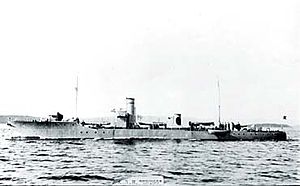HNoMS Stegg (1921)

HNoMS Trygg - HNoMS Stegg's sister ship
|
|
| History | |
|---|---|
|
|
|
| Name: | Stegg |
| Namesake: | the male grouse |
| Builder: | Horten Naval shipyard |
| Yard number: | 111 |
| Launched: | 16 June 1921 |
| Out of service: | 20 April 1940 |
| Struck: | 24 June 1949 |
| Fate: |
|
| Service record | |
| Commanders: | Lieutenant H. M. Hansen (1940) |
| Operations: | Norwegian Campaign |
| Victories: |
|
| General characteristics | |
| Class and type: | Trygg class |
| Displacement: | 256 tons |
| Length: | 53 m (173.88 ft) |
| Beam: | 5.5 m (18.04 ft) |
| Draft: | 1.58 m (5.18 ft) |
| Propulsion: | 3,600 hp steam engine |
| Speed: | 25 knots (46.30 km/h) |
| Complement: | 33 men |
| Armament: |
|
The last of the Trygg class of Royal Norwegian Navy torpedo boats was HNoMS Stegg. Her sister ships were Trygg and Snøgg. The Trygg class vessels were the only additions to the Norwegian fleet of torpedo boats between the First and the Second World Wars. At the outbreak of the Second World War the Trygg class was mobilised together with eight 2. class and six 1. class torpedo boats.
Stegg was constructed at Horten naval shipyard and had yard number 111. She was named after the Stegg, the Norwegian term for the male grouse.
The Stegg had a brief and intense period of service in the Norwegian Campaign after the German invasion of Norway. When the invasion began on 9 April 1940 she was anchored at Skudeneshavn and commanded by Lieutenant H. M. Hansen. She entered the Hardangerfjord on 10 April 1940 and proceeded to capture two German merchant ships; first the 5,295-ton Cläre Hugo Stinnes 1 on 12 April 1940 and then the 6,567-ton iron ore laden Afrika five days later. Together with the 1. class torpedo boat HNoMS Sæl, Stegg escorted Afrika to the port of Odda the same day she was captured. The German crews were held as POWs by Norwegian land forces.
...
Wikipedia
